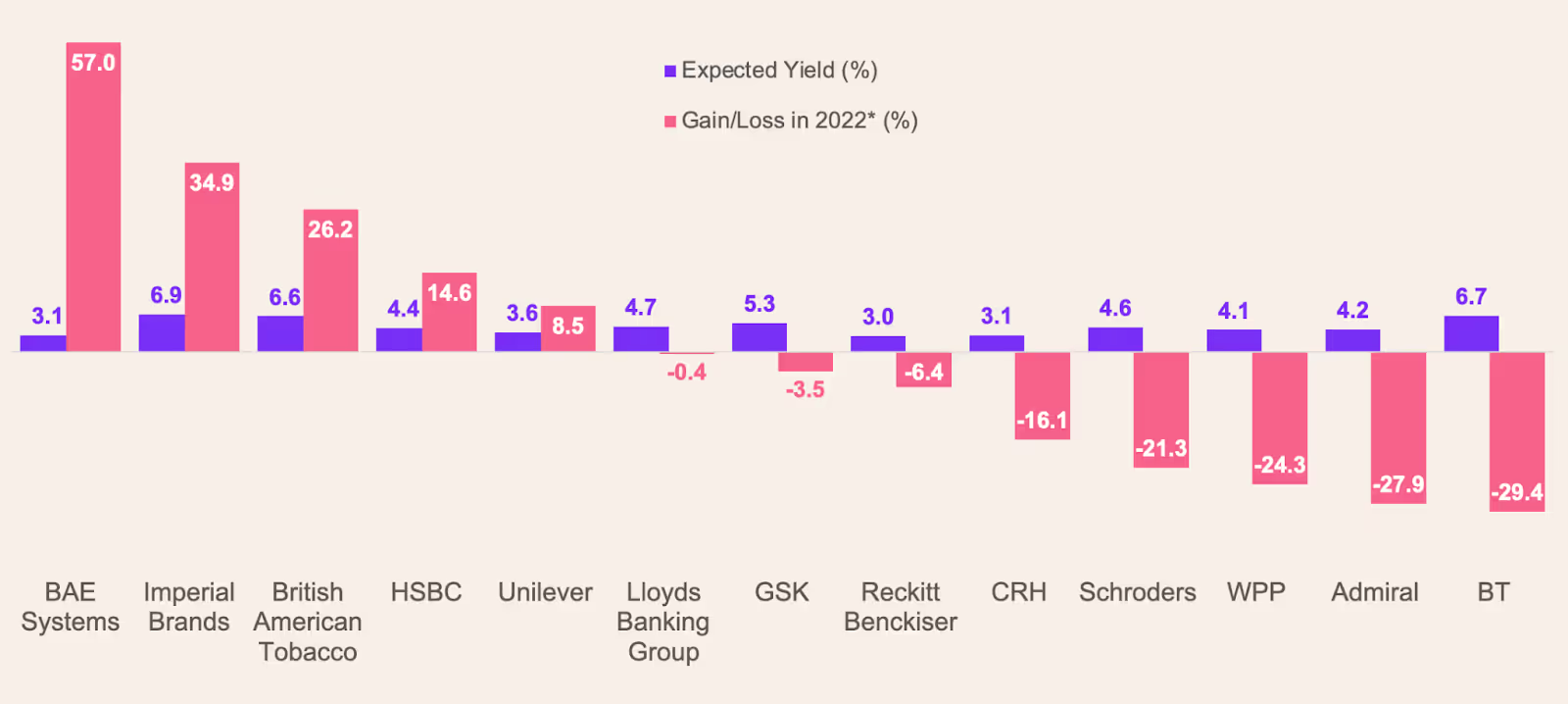UK dividend hunters have had a dizzying few years. Yo-yoing share prices, dividend-paying companies halting payouts over the pandemic and a rush of sporadic special dividends make for a confusing income landscape.
Thankfully, it looks like dividend policies on the UK equity income scene are edging back to normality with the special dividend rush now over and regular dividends on the rise.
Payments from UK dividend stocks look set to rise slightly to £89bn in 2023 according to fund administration firm Link Group. Even still, it predicts UK dividends won’t reach pre-pandemic levels until 2025.
Currency fluctuations have been a tailwind for UK dividend investors heading into 2023 though, with a weak pound and strong dollar set to boost UK dividends by £5.7bn, once the full-year 2022 figures are totted up.
Read more:
Dividends and your stocks and shares ISA
2023 investment tax allowances: ISAs just got real
How to open a stocks and shares ISA with Freetrade
Eligibility to invest into an ISA and the value of tax savings depend on personal circumstances and tax rules may change.
How did UK dividend yield stocks perform in 2022?
Link’s stats offer a few encouraging signs that dividend stocks are regaining confidence across the board. But there are still some sector and stock-specific stories playing out, which point to selectivity among UK dividend stocks being key in 2023.
For a better view of these narratives, and how to tackle them this year, let’s look at how some of the biggest UK dividend payers fared in 2022.
It’s important to highlight that this is a wrap-up, not a suggestion or recommendation that you buy or sell any of the securities mentioned.
Remember that everyone has their own goals and unique financial circumstances. These, along with your tolerance for investment risk and time horizon, should inform the mix of assets in your portfolio.
Our resource hub for investing in the stock market might be able to help make that blend a bit clearer for you and our guide on how to invest in stocks is a great start for first-time investors. And if you are still unsure of how to pick investments speak to a qualified investment advisor.
Top UK dividend stocks of 2022. Total return, Jan - Dec 2022

Source: FE, as at 16 November 2022. Basis: bid-bid in local currency terms with income reinvested.
UK dividend stocks on Freetrade
- BAE Systems (BA)
- Imperial Brands (IMB)
- British American Tobacco (BATS)
- HSBC (HSBA)
- Unilever (ULVR)
- Lloyds (LLOY)
- GSK (GSK)
- Reckitt Benckiser (RKT)
- CRH (CRH)
- Schroders (SDR)
- WPP (WPP)
- Admiral (ADM)
- BT (BT.A)
In terms of methodology here, Morningstar takes the 100 largest UK companies with a dividend yield over 3% and a high barrier to entry, then looks at how they performed over the year, on a total return basis (share price gain + dividend). That 3% threshold is why you won’t see names like Diageo and AstraZeneca, despite their long dividend histories.
It’s one way to slice the data, which ends up excluding some big names like Shell and BP on ‘economic moat’ grounds. Commodity firms don’t have a stranglehold on the likes of oil or gold and so, don’t have a niche that can’t be tapped into or copied.
Read more:
How are my investments taxed?
The (more realistic) ISA millionaire
How to use ISAs for income investing in 2023
While we could spend all day adding or removing companies based on a few more rules, it’s more important to see if there are any general themes to take away and maybe carry into 2023.
And it looks like there are.
First, an uncomfortable truth. When companies whose growth is priced far into the future start to wobble (i.e. US tech in 2022), investors often rush to the firms with predictable and already established revenue streams. A bird in the hand, and all that.
What that meant in 2022 was a dash back to the stocks a lot of investors had tried to stay away from based on ESG, sustainability or ethical grounds. Arms, tobacco, big pharma and banking are a few of those usual suspects to come creeping back onto last year’s buy lists.
The UK’s top-flight index is full of these sectors, so the US’s loss seems to be Blighty’s gain.
It’s a reminder that we just don’t know where growth will come from so diversification is your friend. But, with interest rates still likely to rise until at least the summer of 2023 according to Fed chair Jerome Powell, dividend-paying stocks could play a bigger role than just being a diversifier in many investors’ portfolios this year.
Ultimately, it’s about total return though, not just dividends. And there are bigger reasons why these stocks rose and stuttered throughout the year.
Defence firm BAE Systems popped back up on the radar after the outbreak of war in Ukraine.
Strong global demand for cigarettes and nicotine products, and resilient cash flows to boot, shone a light on Imperial Brands and British American Tobacco.
HSBC’s global banking footprint became more attractive as interest rates started to rise and Unilever’s defensive brand cabinet gained followers at a time of high inflation.
Read more:
Download the Freetrade app here
Five (and a half) tips to boost your dividend income
Five alternative income sources for dividend investors
When you invest, your capital is at risk. The value of your portfolio can go down as well as up and you may get back less than you invest.
On the other side of the coin, shrinking digital advertising budgets hit ad firm WPP. And the backdrop of higher rates and inflation that gave HSBC and Unilever the chance to strut their stuff scuppered the outlook for telecoms stalwart BT. Rising energy costs and expensive network investment were the main culprits.
This is one reason why it’s important to look past the headline yield and give a lot more attention to what’s happening with the actual company and its surrounding environment. Which leads us onto a few more tips for developing a dividend investing strategy in 2023.
How to pick dividend stocks in 2023
Dividend yield vs dividend growth
We’ve previously looked back on the top UK dividend stocks in terms of their dividend yield and offered up some thoughts as to why looking beyond eye-catching yields of 10% or more could be a good idea.
Our overarching message was that while seeking out the highest income-paying stocks is not necessarily a bad place to start, high yields can lure investors into a trap.
It's important to understand the risks that might lurk in the shadows of the high-yield underground.
Dividends are sometimes thought of as passive income, but there is nothing passive about a collapsing share price due to a dividend being slashed.
Just ask shareholders of Imperial Brands who got hit with a dividend cut in 2015 after the company took on too much debt to fund acquisitions.
The sustainability of the dividend is more important than the dividend yield itself. Can those mega payouts continue or are they a flash in the pan? Worse still, are they likely to be cut if the market finds a new trend or the business runs into windfall taxes?
Keep this sustainability mentality in mind as we navigate 2023, and remember to invest in the companies you’d still choose if the yield suddenly dropped.
Here are the top 10 UK dividend stocks, measured by dividend yield.
Current highest-yielding dividend stocks among UK 100 companies
Source: dividenddata.co.uk as at 5 Jan 2023.
Highest-yielding UK dividend stocks on Freetrade
- Persimmon (PSN)
- Rio Tinto (RIO)
- M&G (MNG)
- Vodafone (VOD)
- Barratt Development (BDEV)
- Taylor Wimpey (TW)
- Phoenix Group (PHNX)
- Abrdn (ABDN)
- Legal & General (LGEN)
- Imperial Brands (IMB)
Remember that sometimes those huge dividend yields only look big as a percentage of a falling share price. If a company’s shares started off at 100p with a 5p dividend, that’s 5%. If those shares fall off a cliff, to around 50p, that 5p dividend is now a 10% yield.
That will make it look artificially attractive. It might be a good entry point if everything stays at those levels but companies rarely shrug off a 50% fall in share price. There might be some restructuring, which could involve reducing or skipping a dividend to help shore up the balance sheet.
Top 10 dividend-yielding UK investment trusts
There’s always the option to pay a fee for a professional to do it for you. Here you would hope the manager at the helm would have a decent chance of avoiding the worst of the dividend icebergs, while investing in some growers at the same time.
It’s never a given, though, and it's just as important to do your homework on the professional managers as it is on individual stocks.
The following list shows the current highest yielding investment trusts in the UK. The list strips out funds focused on debt and financing, and looks at the equity and property investment trusts most retail investors look to the sector for.
As their names suggest, some of these trusts invest in equities outside of the UK market and most of the recent highest yielders provide financing for other companies.
UK Investment trusts with the highest dividend yield
Source: dividenddata.co.uk, as at 11 Jan 2023. *Indicates the company has made a dividend cut to the most recent dividend or has stated that the next dividend will be cut.
Top 10 dividend-yielding UK equity investment trusts on Freetrade
- Regional REIT (RGL)
- Civitas Social Housing (CSH)
- Triple Point Social Housing (SOHO)
- Princess Private Equity (PEY)
- European Assets Trust (EAT)
- Henderson Far East Income (HFEL)
- Target Healthcare REIT (THRL)
- EJF Investments (EJFI)
- Alternative Income REIT (AIRE)
- Ediston Property EPIC)
Top 10 dividend heroes
Investment trusts can be particularly helpful investments for income thanks to their structure. Trusts are allowed to reserve up to 15% of their income in the good periods so they can top up payments to investors when dividend income suddenly becomes hard to find.
The pandemic showed how that can, and does, happen from time to time. Investment trust fans will have thanked their lucky stars that these closed-ended funds were able to dip into their reserves when other income-seekers had to put up with a pretty barren dividend landscape.
To be a UK dividend hero, a trust has to consistently increase its dividend for at least 20 years, with some going much further than that.
Top 10 investment trusts with the longest track records of dividend increases
Source: AIC, dividenddata.co.uk, as at 4 Jan 2023. *The Association of Investment Companies (AIC) provides a sector classification system to identify potential investment areas, sectors or regions of interest for investors.
Top 10 trusts with the longest dividend histories on Freetrade
- City of London (CTY)
- Bankers (BNKR)
- Alliance Trust (ATST)
- Caledonia (CLDN)
- Global Smaller Companies (GSCT)
- F&C (FCIT)
- Brunner (BUT)
- JP Morgan Claverhouse (JCH)
- Murray Income (MUT)
- Scottish American (SAIN)
These trusts don’t track any index, it’s up to the human manager at the helm to select the stocks they think hold the best opportunity for stable growth and income.
Be careful of dividend clumping
So, we've seen it's more sensible to look for consistent dividend-yielding stocks than flash-in-the-pan high yield shares. But it's not just a case of snapping up anything connected to these types of companies.
The most popular mutual funds in the Investment Association's equity income sector look incredibly similar to each other.
If you buy a few UK equity income funds without peering under the bonnet, chances are you're doubling or tripling up on the same companies.
Bizarrely, this can mean that while you think you're diversifying, you're actually concentrating your money in just a few companies.
As popular sectors and stocks gather investors, that possibility rises. Every so often, it’s also a good idea to check in with all of your funds - mutual funds, investment trusts and ETFs - to make sure you aren’t overlapping simply by those third-party investors thinking similarly.
Keep it simple, keep it diverse, and keep an eye on exactly what you hold and why.
New UK dividend tax rates from April 2023
While we’re on the topic of how to approach dividend investing in 2023, it’s a good opportunity to talk about dividend tax.
In November 2022 the chancellor teed up UK investors for some big changes to what they can earn in dividend income before the tax people come knocking.
The amount we can earn in dividend income and outright investment growth (capital gains) is falling from April 2023. With both allowances being chopped in half, and then again in 2024, it means a lot of investors will pay tax on their investments for the first time.
If you haven’t thought about investing tax efficiently, then it might be wise to at least work out if a tax-efficient account like a stocks and shares ISA or self-invested personal pension (SIPP) could help now more than ever.
Eligibility to invest into an ISA or SIPP and the value of tax savings both depend on personal circumstances and tax rules may change.
2023/24 dividend and capital gains allowances

If you aren’t investing using a stocks and shares ISA or a longer-term tax-efficient account like a SIPP you could be forking out a load of extra tax come April.
Putting the changes to the dividend allowance into perspective, a basic rate taxpayer earning £2,000 in dividends in the 2022/23 tax year, and earning the same dividend income for the next two years, would suddenly have to pay £87.50 in 2023/24, then £131.25 in 2024/2025.
The rise in dividend tax is even more pronounced for higher rate taxpayers, who would pay £506.25 in 2024/25, and additional rate taxpayers, who’d owe £590.25.

That’s a big chunk of change for anyone, and let’s not forget it could be even bigger if your dividend payments grow, like we all hope they will.
How to invest in dividend stocks in your ISA
If you’ve considered the investment risks and weighed them up against the potential benefits of investing in dividend stocks, here’s a straightforward step-by-step guide explaining how to invest:
- Compare brokerage accounts to decide which one best suits your investing platform needs. Our investment fees calculator will help you understand the charges you could face.
- Open a stocks and shares investment account with your broker of choice. Make sure whatever platform you choose has the range of investments and investment products you need. You might want to factor in tax efficiencies and your time horizon, and consider whether a GIA, stocks and shares ISA or SIPP could help. Once you’ve decided, make your first deposit.
- Research the type of dividend stocks, dividend ETFs or investment trusts you want to invest in. Remember to have an eye on the current yield as well as any indication of future income stability. If there's a big difference between a dazzling headline yield and the actual annual income a trust or stock pays out, that might be a red flag. Unreliable sources of income will only cause worry and stress if you're relying on them, like those investing for retirement income.
- Make sure the mutual funds or individual shares fit in with your overall investment strategy, portfolio diversification, personal risk profile, and that the rest of your finances are still in a healthy position.
- Select how much of a dividend stock you’d like to invest in. You can buy fractional shares on the Freetrade app for US shares, so you don’t have to purchase a full share if it's outside of your budget, or if you’d just like to start with a smaller investment and build up depending on its performance.
As an investor, it’s extremely difficult to consistently pick investments that will succeed no matter what's happening in the world. So, rather than getting bogged down in short-term dividend per-share analysis, keep the broader horizon in mind. If a firm has a clear commitment to paying dividends, that should help its annual compound return over time, even if the company shares have an off year.
We’ve created one of the UK’s leading stock trading apps to help everyone build their wealth over the long term. Join over 1 million users that have chosen Freetrade for their general investment account, investment ISA or personal pension.
Important information on SIPPs
SIPPs are a pension product designed for people who want to make their own investment decisions. You can normally only access the money from age 55 (set to rise to 57 from 6 April 2028).
This article is based on current rules, which can change, and tax relief depends on your personal circumstances. When you invest, your capital is at risk.
Before transferring a pension you should ensure you will not lose valuable guarantees or incur excessive transfer penalties. Pensions are usually transferred as cash so you will be out of the market for a period.
Freetrade does not currently offer drawdown products for our SIPP.
This should not be read as personal investment advice and individual investors should make their own decisions or seek independent advice. This article has not been prepared in accordance with legal requirements designed to promote the independence of investment research and is considered a marketing communication.When you invest, your capital is at risk. The value of your portfolio can go down as well as up and you may get back less than you invest. Past performance is not a reliable indicator of future results.Freetrade is a trading name of Freetrade Limited, which is a member firm of the London Stock Exchange and is authorised and regulated by the Financial Conduct Authority. Registered in England and Wales (no. 09797821).

.avif)




.avif)





